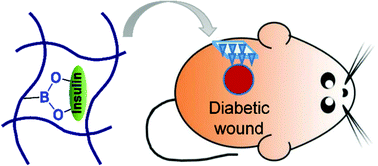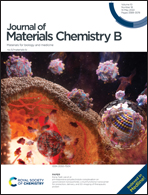Responsive hydrogel-based microneedle dressing for diabetic wound healing†
Abstract
Wound healing is a critical challenge in diabetic patients, mainly due to long-term dysglycemia and its related pathological complications. Subcutaneous insulin injection represents a typical clinical solution, while the low controllability of insulin administration commonly leads to a result far from the optimal therapeutic effect. In this work, we developed a glucose-responsive insulin-releasing hydrogel for microneedle dressing fabrication and then investigated its effects on diabetic wound healing. The hydrogel system was composed of biocompatible gelatin methacrylate (GelMa), glucose-responsive monomer 4-(2-acrylamidoethylcarbamoyl)-3-fluorophenylboronic acid (AFPBA) and gluconic insulin (G-insulin), and the Gel–AFPBA–ins hydrogel-based microneedle dressing was developed by replicating PDMS molds. The resultant hydrogel microneedle dressing exhibited adequate mechanical properties, high biocompatibility, glucose-responsive insulin release behavior upon exposure to different glucose solutions, and potent adhesion to the skin compared to hydrogels without microstructures. The microneedle dressing could accelerate the diabetic wound healing process with decreased inflammatory reaction, enhanced collagen deposition on the regenerated tissue sites, and improved blood glucose control in animals. Therefore, the glucose-responsive insulin-releasing hydrogel microneedle dressing is effective in diabetic wound management and has potential for treatment of other chronic skin injuries.

- This article is part of the themed collections: 2022 Journal of Materials Chemistry B Most Popular Articles and 2023 Journal of Materials Chemistry B Lunar New Year


 Please wait while we load your content...
Please wait while we load your content...